|
|
|
 |
|
| Hanwei Raptor Unokubi Zukuri Katana (SH2415) |
Points: 15

|
The Raptor Unokubi-Zukuri (Cormorants Neck) blade design is patterned after the shape of the Naginata, the powerful long-handled weapon popular between the 12th and 14th centuries. Notable for the strongly relieved shinogi-ji and diamond-shaped kissaki, the Unokubi-Zukuri provides excellent balance in a strong cutting blade.
The blade of the Raptor katana is hand forged in 5160 high carbon steel and is specifically heat treated to produce very high resilience and greater tolerance to misdirected cuts than a conventionally differentially tempered blade.
The blade geometry is configured to facilitate the cutting of both soft and semi hard materials without chipping, allowing the user a wider range of targets.
Cotton wrapped tsuka.
Tsuba, fuchi and kashira features a beautiful Raptor motif.
Black matte finish wood saya.
Comes with black sword bag.
Sold Out
|
|
|
|
|
|
 |
|
| Hanwei Raptor Katana, Nambokucho Zukuri (SH2416) |
Points: 30

|
The Nanbochuko period in Japanese history (the later part of the 14th. century) encompassed sixty years of internal conflict in Japan, which spawned a demand for more and bigger sword blades than ever produced previously.
Sold Out
|
|
|
|
|
|
 |
|
| Hanwei Kouga Ninja-To (SH2430) |
Points: 17

|
The neighboring Kouga and Iga clans of feudal Japan were bitter enemies for centuries and their warring Ninja families have been immortalized in Japanese literature. To commemo- rate these secretive warriors we have introduced our Kouga and Iga Ninja-To.
Sold Out
|
|
|
|
|
|
 |
|
| Hanwei Iga Ninja-To (SH2431) |
Points: 15

|
The neighboring Kouga and Iga clans of feudal Japan were bitter enemies for centuries and their warring Ninja families have been immortalized in Japanese literature. To commemo- rate these secretive warriors we have introduced our Kouga and Iga Ninja-To.
Sold Out
|
|
|
|
|
|
 |
|
| Hanwei Shinto Katana (SH1001) |
Points: 30

|
Each piece in the Shinto Daisho (SH1001 & SH1015) has a hand-forged T10 high-carbon steel blade (nagasa) and is differentially tempered using a traditional claying method. The Shinto Daisho is mounted in black and the tsuka-ito is made of premium black Japanese cotton. The saya is done in a deep black lacquer with a black cotton sageo. A finely rendered dragon, detailed in gold, with true front-and-back detail, forms the black iron tsuba. The fittings are superbly antiqued adding to the aesthetics of the set. The blades feature a groove (bo-hi) on both sides and are constructed with a medium length (chu) kissaki. The incredibly popular Shinto Daisho is the cornerstone of our CAS/Hanwei line of Samurai weapons.
Forged high-carbon steel blade
Built for cutting
Traditional construction
Sold Out
|
|
|
|
|
|
 |
|
| Hanwei Wind & Thunder Katana (SH5001) |
Points: 35
|
This new cutting katana from CAS/Hanwei is designed specifically for the martial artist that needs a sword for the demands of rigorous tameshigiri. The Wind & Thunder features a heavier and thicker blade with traditional furniture and fittings. The Wind & Thunder is fitted with the black iron Raiden tsuba and Tomoe motif fuchi and kashira. The handle is wrapped in genuine same (ray skin) and the tsuka-ito is premium Japanese black cotton. The saya is done in a traditional black laquer and the sageo is also black cotton. This sword is an excellent choice for those intereseted in batto-jutsu.
Thick & Heavy Blade
Hand-forged High Carbon Steel Blade
Great for Tameshigiri
Sold Out
|
|
|
|
|
|
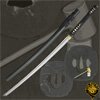 |
|
| Hanwei Tea Culture Katana (SH2331) |
Points: 30


|
In Japan the traditional method of serving tea is a celebrated art form in itself. This highly ritualized ceremony is an involved process, the most elaborate of which can last hours and is reserved for the most distinguished of guests. Our Tea Culture Daisho (SH2331, SH2332) captures the essence of this important tradition. The Katana and Wakizashi are built upon a traditional Shinogi Zukuri style blade with Bo-Hi. The high-carbon blade is hand forged and differentially hardened using the traditional clay method. The Koshirae (furniture) feature the typical elements present in a Japanese tea ceremony. The handle is wrapped with suede leather in a Katati Make (battle wrap) style.
Sold Out
|
|
|
|
|
|
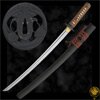 |
|
| Hanwei Three Monkey Wakizashi (SH2330) |
Points: 40

|
The "Three Wise Monkeys" is a popular symbol of the "See no evil, hear no evil, speak no evil" proverb popular in many cultures around the world. The proverb itself is thought to have originated in China and was brought to Japan by a Buddhist monk, while the association with three monkeys appears to be a Japanese play on words. Our Three Monkey Katana (SH2329) and Wakizashi (SH2330) are built on traditional Shinogi Zukuri style blades with Bo-Hi to reduce weight and improve balance. The high-carbon blade is hand forged and differentially hardened. The blackened iron Tsuba features the "Three Wise Monkeys" in relief.
Sold Out
|
|
|
|
|
|
 |
|
| Hanwei Ronin Katana (SH2360) |
Points: 50

|
The Story of the 47 Ronin is one of the most celebrated and influential tales of the Samurai from the Edo period. Lord Asano was a powerful Daimyo ordered by the Shogun to entertain guests of the Imperial Family. The highest ranking master of protocol, Kira, was given the task of teaching Asano, among others, proper matters of etiquette in this task. Lord Asano and Kira quickly grew to dislike each other and the teacher insulted his student at every opportunity. No longer able to contain himself, Asano drew his sword upon Kira, wounding him in the attack. This act led to Asano's ordered suicide (seppuku) and the confiscation of his property. On December 14, 1702, nearly one year after Asano's death, 47 of Asano's men (now Ronin), descended upon the mansion of Kira to exact their revenge.
Sold Out
|
|
|
|
|
|
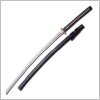 |
|
| Hanwei Tiger Katana (SH1204) |
Points: 51


|
Each piece in the Tiger group has a hand-forged and folded ASSAB-K120C powder steel blade, differentially tempered to produce an HRC60 edge, HRC40 back and a distinctive hamon. Saya are deeply lacquered in black, with inlaid brass bamboo leaves. The ray skin used on the tsuka is of the highest quality, and the tsuka-ito and sageo on all three pieces are woven from best quality Japanese cotton. The Fuchi, Kashira, Kojiri, Koiguchi and Kurigata are all made from blackened bronzed iron, selectively detailed in gold. The Tsuba of the Katana and Wakizashi are made from blackened iron, with a tiger inlaid in brass. The Habaki is of one-piece brass construction. The blades of all three pieces are grooved on both sides, with a short Kissaki on the Katana and Wakizashi. See Models SH1205 and SH1206 for the Wakizashi and Tanto details.
Hand forged and folded steel blades
Excellent quality
Traditional construction
Sold Out
|
|
|
|
|
|
 |
|
| Hanwei Orchid Katana (SH1207) |
Points: 50

|
Each piece in the Orchid Series (SH1207, SH1208, & SH1209) has a hand-forged & folded K120C powder steel blade, differentially tempered using a traditional claying method to produce an HRC60 edge, HRC40 back. The temper line (hamon) is evident and prominent and the grain pattern (hada) shows distinct layers. The saya are deeply lacquered in blue. High quality ray skin (same) is used on the tsuka, and the tsuka-ito and sageo on all three pieces are woven from premium Japanese cotton. The tsuba of the katana and wakizashi is of blackened iron, with an Orchid and Butterfly decoration inlaid in silver, brass and copper. The scabbard mouth (koiguchi) and cord knob (kurikata) are of buffalo horn, and the fuchi, kashira and kojiri are of bronzed iron with silver and gold detailing. The blade collar (habaki) is a one-piece brass construction. The katana and wakizashi feature a medium-length (chu) kissaki. See Models SH1208 and SH1209 for the Wakizashi and Tanto details.
Hand forged and folded steel blade
Excellent quality
Traditional construction
Sold Out
|
|
|
|
|
|
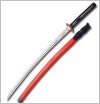 |
|
| Hanwei Kami Katana (SH1201) |
Points: 60
|
Each piece in the Kami group has a hand-forged and folded ASSAB-K120C powder steel blade, differentially tempered to produce an HRC60 edge, HRC40 back and a distinctive hamon. Saya are deeply lacquered in red, with a black ring-carved section at the sageo. The ray skin used on the tsuka is of the highest quality, and the tsuka-ito on the Katana and Wakizashi and the sageo on all three pieces are woven from best quality Japanese silk. The Fuchi, Kashira, Kojiri, Koiguchi and Kurigata are all made from blackened bronze, with decoration in relief and selective detailing of copper, silver and gold. The Tsuba of the Katana and Wakizashi, depicting the Kami, or Guardian Warriors, are made from hardened blackened copper, with decoration in relief and selective silver and gold detailing. The Habaki is of two-piece construction, the inner section being copper and the outer section gold-plated brass. The blades are engraved, at the Habaki, with a hand-engraved "Fudo" horomono, a traditional blade carving from the Edo period. The blades of all three pieces are grooved on both sides, and each piece features a long Kissaki. See Models SH1202 and SH1203 for the Wakizashi and Tanto details.
Forged-Folded K120C High-Carbon Steel
Differential Heat-Treatment
Traditional Construction
Sold Out
|
|
|
|
|
|
 |
|
| Hanwei Praying Mantis Katana (SH2359) |
Points: 55

|
The Praying Mantis is a symbol of cunning and power in Japanese culture and is consequently a highly respected theme in Samurai swords. Built on our new L6/Bainite blade (detailed below) in the Shobu Zukuri style with Bo-Hi, and featuring superb koshirae, the Praying Mantis is a very desirable and functional piece. The subdued green silk ito and deep brown of the lacquered saya provide handsome contrast to the dark copper and golden accents of the tsuba, fuchi and kashira. The stalking mantis lies in wait for his next prey, mirroring the power and grace in this exceptional katana.
Sold Out
|
|
|
|
|
|
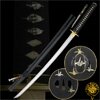 |
|
| Hanwei Paper Crane Katana - Tamahagane (SH2294) |
Points: 100

|
Our Paper Crane Daisho (SH2294-Katana / SH2328-Wakizashi) is without doubt the greatest achievement in sword making artistry yet available from Hanwei. The blade is crafted from Hanwei's own Tamahagane steel (see below) while the fittings reflect the atmosphere of the Japanese theater. The Daisho's name stems from the origami (the art of paper folding) cranes that decorate the striking Tsuba and Fuchi/Kashira, all of which feature highly-prized "Nanako" or stippled backgrounds. The Menuki feature thespian masks, a symbol shared by the Japanese theater and its western counterpart. The Saya of the katana houses a Kozuka (small knife) while that of the Wakizashi carries a Kogai (hair pick) The Kozuka and Kogai are decorated with musical instruments of the theater. The Paper Crane theme is carried to the outstanding hand woven silk Sageo, the result of many hours of skilled work on a hand loom.
Sold Out
|
|
|
|
|
|
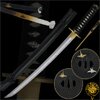 |
|
| Hanwei Paper Crane Wakizashi - Tamahagane (SH2328) |
Points: 60

|
Our Paper Crane Daisho (SH2294-Katana / SH2328-Wakizashi) is without doubt the greatest achievement in sword making artistry yet available from Hanwei. The blade is crafted from Hanwei's own Tamahagane steel (see below) while the fittings reflect the atmosphere of the Japanese theater. The Daisho's name stems from the origami (the art of paper folding) cranes that decorate the striking Tsuba and Fuchi/Kashira, all of which feature highly-prized "Nanako" or stippled backgrounds. The Menuki feature thespian masks, a symbol shared by the Japanese theater and its western counterpart. The Saya of the katana houses a Kozuka (small knife) while that of the Wakizashi carries a Kogai (hair pick) The Kozuka and Kogai are decorated with musical instruments of the theater. The Paper Crane theme is carried to the outstanding hand woven silk Sageo, the result of many hours of skilled work on a hand loom.
Sold Out
|
|
|
|
|
|
|
|
Tags:
martial arts, katana, iaito, sword, fencing, tonfa, boken, bokken, kama, shinai, samuraj, judo, karate, kenjutsu, kenjitsu, ninja, kungfu,
|









